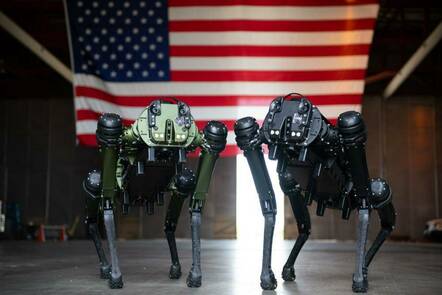Let's give these quadruped robot dogs next-gen XM7 rifles, says US Army
Black Mirror? Never heard of it
Sometimes it feels like the most terrifying ideas from science fiction are simply fodder for the future of the military - case in point, word reaching us that the US Army wants to strap its next-gen service rifle to the top of robot sentry dogs.
The Army envisions attaching its new Sig Sauer XM7 rifle to a Ghost Robotics Vision 60 quadruped unmanned ground vehicle (Q-UVG) to accompany infantrymen, Bhavanjot Singh, senior scientific technical manager at the US Army's Combat Capabilities Development Command (DEVCOM), said this month.
"The unique capability of the dog is the ability to traverse different types of terrain that wheeled vehicles may not be able to go," Singh said, according to defense news outlet Janes.
The Vision 60 was designed with such capabilities in mind, as Ghost Robotics demonstrated in 2021 at an Army trade show in Washington, DC. The manufacturer showed off one of its four-legged bots and an attached rifle with a 10-round capacity and the ability to strike targets up to three-quarters of a mile away at the show. Ghost Robotics' demonstration system wasn't autonomous, however, and requires a human operator to remotely control the machine and pull the trigger - the Vision 60 can't do so on its own - yet.
The Department of Defense's regulations on autonomous weapons systems were updated earlier this year, and still require a human controller to be the one to make engagement decisions.
It's not clear whether Singh's prognostication about the future of robot dogs involves any added autonomy beyond what currently exists, and The Register didn't receive a response from DEVCOM to questions for this story.
Walkabouts today, firearms in the future?
While the US military hasn't fielded anything close to an armed robot dog, it has deployed unarmed Vision 60 Q-UVGs to multiple facilities, such as the US Space Force's Cape Canaveral base and Cape Cod station in Massachusetts to take on patrol responsibilities and ease the burden on security teams.
The US Air Force has also fielded the Vision 60 for use in responding to chemical, biological, radiological, and nuclear disaster scenarios.
But garrison duty and short-term incident response is a very different beast from field deployments, and the US Army said last year that it expected even unarmed Q-UVGs will need an additional decade of development before they're ready for service with the US military's oldest branch.
"These legged platforms have some promises which we've identified, primarily from a mobility standpoint," Army Ground Vehicle Systems Center dismounted robotics system branch chief Milot Resyli said. However, Resyli added, "there are limitations to them as well from an endurance [perspective], as well as the payload capability and power of how much they can support."
- US Space Force deploys robot dogs at Cape Canaveral base
- NYC Mayor: Robo-pup 'out of the pound' and back to police work
- Russian military uses Chinese drones and bots in combat, over manufacturers' protests
- What's that, Lassie? Boston Dynamics is suing its robot dog tech rival?
While The Register wasn't able to reach anyone at DEVCOM to ask additional questions about the prospect of deadly robot dogs evocative of a Black Mirror episode, the group did answer questions put to it by Military.com, and its responses indicate the concept of arming robot dogs is just that - a concept.
"Advanced technology demonstrations … allow us to explore the realm of the possible when it comes to transformative capabilities for future combat formations, they don't necessarily represent or result in formal service-wide research programs or investments," a DEVCOM spokesperson said.
In Europe, meanwhile, embattled Ukrainian forces have already been fielding remote-controlled machine gun drones in their fight against Russia, complete with a kamikaze variant outfitted with anti-tank explosives.
Russia has also reportedly developed its own armed robot dog, though reports suggest the whole thing may also have been less next-gen tech, and more a scam by Russian defense contractors hoping to claw some rubles out of the Kremlin.
Global robotics firms not so sure about all this - to a point
Boston Dynamics, whose first commercial remote-control robot was the four-legged Spot that's similar enough to the newer Vision 60 that it resulted in a lawsuit, has expressed reservations about the prospect of arming advanced robots.
Along with Agility Robotics, Swiss firm ANYbotics, Canada's Clearpath Robotics, China's Unitree Robotics and Open Robotics, Boston Dynamics penned an open letter last year pledging not to weaponize their technology.
"We pledge that we will not weaponize our advanced-mobility general-purpose robots or the software we develop that enables advanced robotics and we will not support others to do so," the group of six robotics firms decreed.
"Boston Dynamics supports non-weaponized uses of its robots by military personnel, and our robots are already in use by US and allied militaries in several important government and public safety applications," Boston Dynamics told us in an email.
Armed or not, the use of Boston Dynamics robotic dogs by police forces around America has still drawn discussion from the public and local lawmakers.
In Los Angeles, where the city council voted 8-4 in May to accept the donation of a Boston Dynamics Spot worth $270k from the Los Angeles Police Foundation, council members and the public expressed "grave concerns" about police use of the device.
LA councilwoman Eunisses Hernandez, who skipped the vote on accepting the donation, described the robots to CBS as "depersonalized, military-style technology," adding that residents in New York and San Francisco have similarly fought back against adoption of the bots.
Citizens and local officials in New York raised such a fuss, in fact, that the NYPD terminated their lease with Boston Dynamics for Spot robots in 2021 before Mayor Eric Adams reintroduced them earlier this year. ®

 Biting the hand that feeds IT
Biting the hand that feeds IT